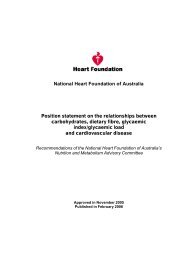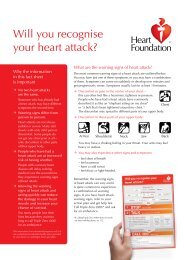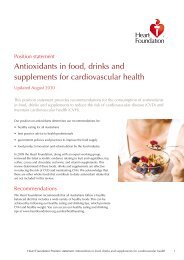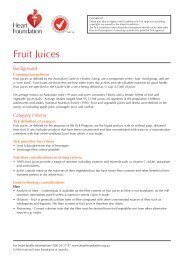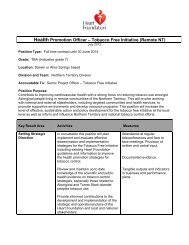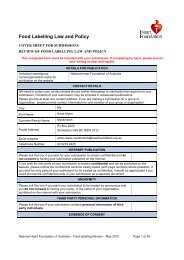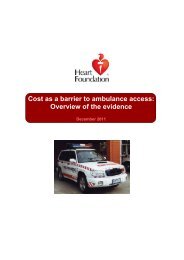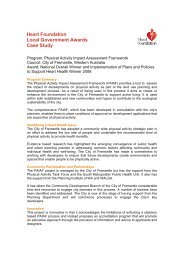Healthy by Design - National Heart Foundation
Healthy by Design - National Heart Foundation
Healthy by Design - National Heart Foundation
You also want an ePaper? Increase the reach of your titles
YUMPU automatically turns print PDFs into web optimized ePapers that Google loves.
Walking and cycling routes<br />
A well-planned network of walking and cycling routes allows people to<br />
travel safely and with ease, whether on foot, bike or other wheeled vehicles.<br />
The best walking and cycling routes include a well-connected network of<br />
footpaths, shared paths for pedestrians and cyclists, off road cycle paths, on<br />
road cycle lanes and paths for recreation and leisure.<br />
<strong>Design</strong> objective<br />
To provide an accessible integrated network of walking and cycling<br />
routes for safe and convenient travel to local destinations and<br />
points of interest.<br />
<strong>Design</strong> considerations<br />
Make connections<br />
• Plan walking and cycling routes that provide variety, offering<br />
both direct and leisurely paths.<br />
• Provide route continuity through local streets, linking footpaths<br />
with shared paths and providing access through road closures<br />
and cul-de-sacs.<br />
• <strong>Design</strong> walking and cycling routes to lead to local destinations<br />
and popular focal points such as shops, food stores, schools,<br />
parks and public transport stops.<br />
• Achieve clear and safe connections through signage,<br />
landscaping, lighting and edge treatments.<br />
Create safe places for people to walk and cycle<br />
• Create places for people to walk where they can be seen <strong>by</strong><br />
cyclists, other pedestrians, motorists and near<strong>by</strong> residents.<br />
Avoid tunnels and underpasses that limit visibility.<br />
• <strong>Design</strong> footpaths to be overlooked <strong>by</strong> dwellings and<br />
other buildings.<br />
• Ensure clear sightlines along walking and cycling routes using<br />
appropriate landscaping, low walls or permeable fencing, mirrors<br />
and effective lighting. Avoid blank walls or high and solid fencing.<br />
• Maintain clear sightlines along walking and cycling routes using low<br />
vegetation (up to 700 mm). Trim tree foliage up to an overhead<br />
clearance of 2400 mm above ground level (refer AS1428.1).<br />
Create stimulating and attractive routes<br />
• <strong>Design</strong> walking and cycling routes to and around local<br />
landmarks and points of interest.<br />
• Use art to encourage interest and repeated use of the route.<br />
• Complement walking and cycling routes with trees for<br />
aesthetics and shade.<br />
• Maintain walking and cycling routes to a high standard to<br />
ensure continuous, accessible paths of travel.<br />
• Maximise shade over paths and near<strong>by</strong> rest stops, ensuring<br />
shade structures do not obstruct access.<br />
For further information on shade provision, refer to The Cancer Council Victoria’s<br />
‘Shade for Everyone’. Contact SunSmart on 03 9635 5148 or visit<br />
www.sunsmart.com.au.<br />
<strong>Design</strong> safe, accessible footpaths<br />
• Enable comfortable passage for people in wheelchairs, people<br />
with prams, learner cyclists and people walking comfortably side<br />
<strong>by</strong> side with footpaths that are:<br />
- A minimum of 1.5 metres wide along collector or lower<br />
order streets.<br />
- A minimum of 2.5 metres wide along arterial roads and<br />
approach routes to predictable destinations such as schools,<br />
parks and shopping precincts. (Three metre paths or wider<br />
are preferred to allow for greater contingency).<br />
• Provide protection from passing cars for people on paths with a<br />
minimum outer nature strip provision of 0.5 metres. Choose<br />
‘barrier’ not ‘rollover’ kerb design.<br />
• Provide footpaths, ideally, on both sides of all streets.<br />
• Provide walking routes along predictable paths of travel,<br />
including approaches to schools, parks and shopping precincts.<br />
• Ensure a durable, non-slip surface and even paving designed<br />
and constructed for minimum maintenance.







